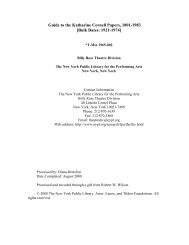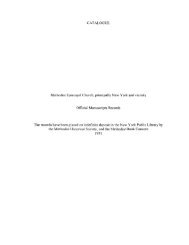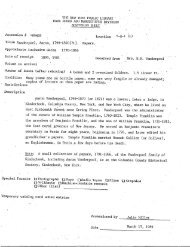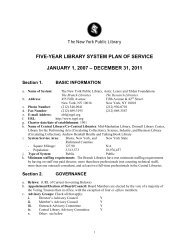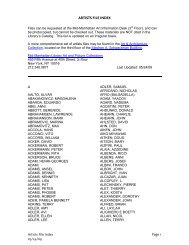View PDF finding aid (68.53 KB) - New York Public Library
View PDF finding aid (68.53 KB) - New York Public Library
View PDF finding aid (68.53 KB) - New York Public Library
You also want an ePaper? Increase the reach of your titles
YUMPU automatically turns print PDFs into web optimized ePapers that Google loves.
KURT FISHER / HAITIAN HISTORY<br />
COLLECTION<br />
1727-1958<br />
The <strong>New</strong> <strong>York</strong> <strong>Public</strong> <strong>Library</strong><br />
Schomburg Center for Research<br />
in Black Culture<br />
515 Malcolm X Boulevard<br />
<strong>New</strong> <strong>York</strong>, <strong>New</strong> <strong>York</strong> 10037<br />
Micro<br />
R2228
TABLE OF CONTENTS<br />
Table of Contents..........................i<br />
Introduction...............................1<br />
Chronology.................................2<br />
Scope and Content..........................6<br />
Container List.............................11<br />
Separation Record..........................17<br />
ii
FISHER, KURT / HAITIAN HISTORY COLLECTION, 1727-1<br />
13 boxes. Also available on 14 reels microfilm. 958.<br />
Introduction<br />
Kurt Fisher, archaeologist and authority on Haitian history and<br />
culture, was born in Vienna in 1908 into a long established<br />
family of art collectors and antique dealers. While a student at<br />
the gymnasium, he became interested in West Indian history and<br />
wrote a thesis on Henry Christophe. After completing his studies<br />
in archaeology at the University of Vienna he emigrated in 1938<br />
to Haiti where he settled and pursued his studies in<br />
Pre-Columbian archaeology. From 1941 to 1949 Fisher was<br />
assistant director of the Bureau of Ethnology of Haiti. Married<br />
to a Haitian woman of social prominence, Fisher continued his<br />
life long interest in collecting, bringing together a large and<br />
important collection of military miniatures as well as the source<br />
materials relating to Haiti, herein described.<br />
The Kurt Fisher/Haitian History Collection was purchased by the<br />
Schomburg Center for Research in Black Culture, in 1969 together<br />
with Fisher's library of books about Haiti.<br />
Note:<br />
The bulk of the collection is in French. There is no English<br />
translation available, although the title of some documents have<br />
been translated in this inventory, for the sake of convenience.
Chronology of Haitian history<br />
I 1492-1803<br />
6 Dec. 1492 Christopher Columbus landed in Haiti.<br />
1509 Introduction of African slaves in Haiti,<br />
named Hispaniola by the Spanish settlers.<br />
1625 Occupation of Tortuga Island, off the<br />
northern coast of Haiti by French and British corsairs.<br />
1697 Ryswick Treaty between France and Spain:<br />
Spain retains the eastern two-thirds of the island, while<br />
France gains control of the western part of the island which<br />
became Haiti.<br />
20 May 1743 Birth of Toussaint Louverture on the Breda<br />
plantation.<br />
14 Aug. 1791 Bois Caiman uprising under Boukman.<br />
28 Nov. 1791 A three-member Civil Commission sent by the<br />
French National Assembly arrives in San Domingo.<br />
18 Sep. 1792 Arrival of second Civil Commission:<br />
Sonthonax, Polverel and Ailhaud.<br />
7 March 1793 British-Spanish coalition against France.<br />
Aug. 1793 Spain occupies eleven cities in the North and<br />
the West.<br />
21 Sep. 1793 Sonthonax proclaims the general emancipation<br />
of the slaves in the West and the North.<br />
Sep. 1793 Adam Williamson, British governor of Jamaica<br />
occupies Jeremie in the South and Mole St. Nicholas in the<br />
North.<br />
9 Oct. 1793 Polverel proclaims the general emancipation<br />
of the slaves in the South.<br />
18 May 1794 Toussaint Louverture leaves the Spanish army<br />
and joins the French side in San Domingo.<br />
20 March 1796 Villate incident.<br />
12 May 1796 Third Civil Commission arrives at the Cap.<br />
May 1797 Toussaint Louverture, Lieutenant-Governor of<br />
the colony becomes General-in-Chief of the San Domingo army.<br />
24 Aug. 1797 Toussaint Louverture forces Sonthonax to<br />
leave San Domingo.<br />
27 March 1798 General Hedouville arrives at San Domingo.<br />
Aug. 1798 The British troops under Maitland evacuate<br />
the island.<br />
31 Aug. 1798 Secret Trade and Neutrality Treaty between<br />
Toussaint Louverture and Maitland.<br />
22 Oct. 1798 Toussaint Louverture forces Hedouville to<br />
leave San Domingo.<br />
30 April 1799 Treaty between Toussaint Louverture and U.S.<br />
Consul Stevens.<br />
13 June 1799 Beginning of civil war in the South between<br />
Rigaud and Toussaint Louverture.<br />
14 Aug. 1799 Toussaint Louverture writes to U.S. President<br />
John Adams to request military assistance in his campaign<br />
2
against Rigaud.<br />
Aug. 1800 Toussaint Louverture marches in triumph with<br />
his troops in Les Cayes; Rigaud is defeated.<br />
Jan. 1801 Toussaint Louverture's troops invade the<br />
eastern part of the island.<br />
27 Jan. 1801 Toussaint Louverture marches in triumph into<br />
Santo Domingo.<br />
8 July 1801 Promulgation of the Charte Fondamentale, the<br />
Constitution drafted in May 1801 by the San Domingo General<br />
Assembly.<br />
Oct. 1801 Peasant insurrection in the North. Moise<br />
incident.<br />
24 Nov. 1801 Execution of General Moise at Port-de-Paix.<br />
29 Jan. 1802 The fleet carrying the French Expeditionary<br />
Army arrives at Cap Samana, in the eastern section of the<br />
island.<br />
17 Feb. 1802 First campaign of the Expeditionary Army.<br />
6 May 1802 Toussaint Louverture surrenders to General<br />
Leclerc. His officers retain their ranks in the French<br />
army.<br />
8 June 1802 Treachery of the French general Boudet and<br />
arrest of Toussaint Louverture.<br />
July 1802 Slavery is reinstated in the island of<br />
Guadeloupe.<br />
5 Oct. 1802 Execution of Charles Belair, nephew of<br />
Toussaint Louverture and his wife Sanite.<br />
They were both captured by Dessalines.<br />
13 Oct. 1802 Alexandre Petion leaves the French army and<br />
joins the rebels.<br />
17 Oct. 1802 Defection of Dessalines from the French army<br />
to the insurgent army.<br />
1 Nov. 1802 Death of Leclerc.<br />
17 Nov. 1802 Petion-Dessalines alliance.<br />
7 April 1803 Death of Toussaint Louverture at the<br />
Fort-de-Joux in France.<br />
15 May 1803 Arcahaie Congress: Dessalines becomes<br />
General-in-chief of the independence army.<br />
18 May 1803 Creation of the Haitian flag.<br />
18 Nov. 1803 The battle of Vertieres.<br />
19 Nov. 1803 Surrender of Rochambeau, General-in-chief of<br />
the French Expeditionary army after the death of Leclerc.<br />
II 1804-1915<br />
1 Jan. 1804 Proclamation of Haitian independence.<br />
Dessalines takes the title of General Governor for life.<br />
6 Oct. 1804 Dessalines is crowned Emperor of Haiti.<br />
17 Oct. 1806 Dessalines is killed in an ambush near<br />
Port-au-Prince.<br />
28 Dec. 1806 The Constituent Assembly chooses Henri<br />
Christophe as president of the Republic of Haiti.<br />
1 Jan. 1807 Beginning of the civil war between the troops<br />
3
of the North under Christophe and those of the West under<br />
Petion.<br />
17 Feb. 1807 Christophe adopts an "Acte constitutionel<br />
d'Haiti" which makes him President of Haiti.<br />
11 March 1807 The Senate in Port-au-Prince elects Alexandre<br />
Petion president of Haiti.<br />
3 Nov. 1810 Andre Rigaud creates the "Etat du Sud,"<br />
splitting the country in three.<br />
9 March 1811 Reelection of Petion.<br />
26 March 1811 Christophe is crowned King of Haiti.<br />
18 Sep. 1811 Death of Andre Rigaud.<br />
March 1812 Re-union of the South and the West under<br />
Petion.<br />
29 March 1818 Jean Pierre Boyer is sworn president of<br />
Haiti.<br />
8 Oct. 1820 Death of Christophe.<br />
26 Oct. 1820 Re-unification of the West and the North<br />
under Boyer.<br />
2 Feb. 1822 Conquest of the Eastern part; the whole<br />
island is unified under Boyer.<br />
Feb. 1843 1843 revolution; downfall of the Boyer<br />
regime.<br />
1843-1844 Riviere Herard, president.<br />
1844-1845 Philippe Guerrier, president.<br />
1845-1846 Jean Louis Pierrot, president.<br />
1846-1847 Jean Baptiste Riche, president.<br />
1847-1859 Faustin Soulouque, president, emperor.<br />
1859-1867 Fabre Nicholas Geffrard, president.<br />
1867-1869 Sylvain Salnave, president.<br />
1870-1874 Nissage Saget, president.<br />
1874-1876 Michel Domingue, president.<br />
1876-1879 Boisrond Canal, president.<br />
1879-1888 Lysius Felicite Salomon, president.<br />
1888-1889 Francois-Denys Legitime, president.<br />
1889-1896 Florvil Hyppolite, president.<br />
1896-1902 Tiresias Simon Sam, president.<br />
1902-1908 Nord Alexis, president.<br />
1908-1911 Antoine Simon, president.<br />
1911-1912 Cincinnatus Leconte, president.<br />
1912-1913 Tancrede Auguste, president.<br />
1913-1914 Michel Oreste, president.<br />
Feb.-Oct. 1914 Oreste Zamor, president.<br />
1914-1915 Davilmar Theodore, president.<br />
March-July 1915 Vilbrun Guillaume Sam, president<br />
III 1915-1983<br />
28 July 1915 Vilbrun Guillaume Sam is killed by a<br />
Port-au-Prince mob; invasion of Haiti by the U.S. Marines.<br />
2 Aug. 1915 Sudre Dartiguenave, president.<br />
16 Sep. 1915 Convention between the United States and<br />
Haiti.<br />
4
19 June 1918 <strong>New</strong> Constitution of Haiti.<br />
1 Nov. 1919 Death in an ambush of Charlemagne Peralte,<br />
leader of the Caco uprising against the U.S. occupation.<br />
1922-1926 Lois Borno, president.<br />
12 April 1926 Reelection of Louis Borno for a period of<br />
four years.<br />
1930-1941 Stenio Vincent, president.<br />
July 1934 Withdrawal of the U.S. marines from Haitian<br />
territory; end of the occupation.<br />
16 Oct. 1937 Thousands of Haitian migrant workers are<br />
slaughtered in the Dominican Republic.<br />
1941- 1946 Elie Lescot, president.<br />
7 Jan. 1946 Beginning of the student rebellion which led<br />
to the downfall of the Lescot regime, four days later.<br />
1946-1950 Dumarsais Estime, president.<br />
1950-1956 Paul Eugene Magloire, president.<br />
22 Sep. 1957 Francois Duvalier, president.<br />
14 June 1964 Francois Duvalier annointed president for<br />
life.<br />
April 1971 Death of Francois Duvalier. His designated<br />
successor, Jean Claude Duvalier becomes president for life.<br />
5
Scope and Content<br />
The bulk of the Kurt Fisher/Haitian History Collection consists<br />
of the Archives of the General Prosecutor's office for the city<br />
of Jeremie (district and municipality in the south of Haiti),<br />
registers and notorized acts from the public notaries of Jeremie,<br />
historical letters and documents from the pre-independance era,<br />
records of the Foreign Relations Ministry from the late 1870s to<br />
the 1950s, administrative records and governmental decrees and<br />
regulations, newspapers and photographs. The scope of the<br />
collection is very broad: the material spanning the three main<br />
periods in Haitian history is disseminated throughout the five<br />
series in the collections (General Correspondence, Executive<br />
Correspondence, Government Papers, Writings and Printed Matter).<br />
The Records of the General Prosecutor's Office and the registers<br />
of the public notaries of the district and municipality of<br />
Jeremie document the administration of justice, trade, various<br />
social relations and patterns of life under colonial rule and<br />
during the formative years after independence. These records<br />
consist primarily of correspondence between the General<br />
Prosecutor's office and the Civil Court judges in the district of<br />
Jeremie, financial reports, minutes of proceedings, police<br />
reports and deeds of property. Included is one A.L.S.* (1852)<br />
from Lysius Felicite Salomon, Duke of Saint Louis du Sud and<br />
Finance Minister in the administration of Emperor Faustin<br />
Soulouque, a famed economist and future president of Haiti,<br />
dealing with the issuing of licenses and naturalization papers to<br />
foreign traders [1:9].** These documents also reflect the<br />
peculiar situation of the city of Jeremie vis a vis the rest of<br />
the colony. Jeremie was under British rule from 1794 to 1798,<br />
and while the General Emancipation Act of 1793 had freed the<br />
slaves throughout French San Domingo, deeds of property and<br />
registers of the parrish and municipality of Jeremie in that<br />
period document the uninterrupted traffic and ownership of slaves<br />
[8:5, 6, 7].<br />
Historical documents from Toussaint Louverture's administration<br />
and the War of Independence. Included is one A.L.S. from Andre<br />
Rigaud to the governor of Jamaica (1799), requesting military<br />
assistance ln his losing battle against Toussaint Louverture in<br />
the province of the South [8:1]. Rigaud was defeated, and while<br />
in exile in France, he sent two A.L.S. (Oct. 1801) and a detailed<br />
military resume [8:8] to the French Minister of Marine and<br />
Colonies, offering his experience and expertise in the planning<br />
and execution of the "Expeditionary Army" destined to rid San<br />
Domingo of Toussaint Louverture. Another document entitled<br />
"Excerpt from a Memoir on San Domingo" [8:10] mentions a letter<br />
*Autograph Letter Signed.<br />
**Numbers in brackets refer to box and folder where the document<br />
is located.<br />
6
sent by Andre Rigaud to General Geffrard, head of the insurgent<br />
army in the South. This documents quotes Rigaud as instructing<br />
Geffrard and the insurgent army to strike at once and kill all<br />
the French in the colony with the certainty that France would not<br />
be able to retaliate for the next twelve years. The interception<br />
of this letter by the French troops resulted in Rigaud's<br />
deportation by Charles Leclerc in 1803. Upon his return to Haiti<br />
in 1810, Rigaud was to take advantage of his appointment by<br />
President Alexandre Petion as administrator of the province of<br />
the South to issue a "Proclamation to the people of the South"<br />
[8:10], establishing an "Etat du Sud," independently from the<br />
"Republic of Haiti" in the West and the "Kingdom of Haiti" in the<br />
North.<br />
The executive correspondence of Toussaint Louverture contains<br />
many noteworthy items, including: a 22 Jan. 1802 letter addressed<br />
to the San Domingo General Assembly [7:15], in which he reaffirms<br />
his loyalty to France, while accusing the "Expeditionary Army" of<br />
planning the reinstatement of slavery in the colony; 3 A.L.S.<br />
from Paul Louverture (Feb. 1802), Commander in Chief of the Ozama<br />
province, announcing the naval siege of that province by the<br />
French flotilla and one holograph copy of Napoleon's<br />
"Proclamation to the inhabitants of San Domingo" [7:16]; 5 A.L.S.<br />
from Charles Belair (31 March- 5 May 1802) [7:16], reporting his<br />
evacuation of the city of Saint Marc and retreat to the<br />
neighboring hills and commenting on the unnecessarily inhuman<br />
treatment of the peasants by Dessalines, as well as the latter's<br />
arbitrary appropriation of large sections of his troops; and one<br />
A.L.S. from Charles Leclerc, General in Chief of the<br />
"Expeditionary Army" (5 May 1802) [7:16], informing him of a<br />
peace treaty between France and Great Britain. (Toussaint<br />
Louverture resigned the same day.)<br />
In addition, two A.L.S. from Martial Besse to Andre Rigaud and<br />
one letter from Rigaud to the French agent Roume [1:1], one<br />
A.L.S. from Charles Belair to Dessalines (7 July 1802) [1:2], as<br />
well as two A.L.S. from the French general Rochambeau and five<br />
A.L.S. to General Leclerc [1:2] are located in the GENERAL<br />
CORRESPONDENCE series.<br />
Among the documents in the GOVERNMENT PAPERS series can be found<br />
one excerpt from the Journal des Colonies entitled: "Report to<br />
the municipality on the slave insurrection of Limbe, Aug. 17 and<br />
18," (1792) [8:5]; one anonymous report on Dessalines' "betrayal"<br />
of Toussaint Louverture [12:1]; and one holograph document<br />
entitled "Secret memoir on the character of Toussaint Louverture,<br />
Dessalines and Charles Belair" [8:10]. The latter tells how to<br />
blackmail Toussaint by using his children, and subvert his<br />
generals by pledging to maintain them in their posts.<br />
7
The Records of the Foreign Relations Ministry consist of letters,<br />
reports and fact sheets dispatched from Haitian legations in<br />
Washington, Santo Domingo, Paris, Berlin and Brussels to the<br />
Haitian Foreign Ministry, correspondence between the foreign<br />
legations in Port-au-Prince and the Haitian Foreign Ministry,<br />
presidential memoranda to the Foreign Relations Ministry and<br />
ceremonial greetings from foreign heads of state to various<br />
Haitian presidents. These documents date to the 1870s when Haiti<br />
was under the influence of the European powers, France and<br />
Germany in particular. It was not until the beginning of the<br />
20th century that U.S. economic interests began to compete<br />
decidedly with the European powers. The turning point occured in<br />
1915 when the U.S. resolutely brought Haiti into its sphere of<br />
influence by the military occupation of the country. Two key<br />
documents in the collection illustrate that transition period:<br />
the deed of a 40 million franc loan agreement [10:12] contracted<br />
in 1895 between the Haitian government and a French consortium<br />
called the National Bank of Haiti, and a deed of transfer of all<br />
titles and securities (including the Haitian national debt) owned<br />
by the National Bank of Haiti to the National City Company of <strong>New</strong><br />
<strong>York</strong> in 1920 [11:5].<br />
As the Monroe doctrine started unfolding toward the end of the<br />
l9th century, the U.S. began pressuring Haiti to cede Mole St.<br />
Nicholas at the north-western tip of the island as a U.S.<br />
military base. In a long, undated report to President Hyppolite<br />
(1889-1896) [6:11], Ambassador to Washington, Hannibal Price,<br />
links the issue of the Mole to a tentative plot to overthrow the<br />
president and the dismissal of Frederick Douglass, American<br />
Ambassador to Port-au-Prince from 1889 to 1891. A string of<br />
claims submitted by U.S. nationals as well as French and German<br />
traders throughout the second half of the l9th century and the<br />
beginning of the 20th century, runs through the diplomatic files:<br />
the "Laetitia" incident, 1882 [2:5]; "Haitian Republic," 1892<br />
[2:8]; various German traders, 1889 [3:4]; Antoine Benoit, 1911<br />
[4:2], among others. In 1911, the Haitian government set up a<br />
special commission to settle all pending claims involving foreign<br />
traders [4:2]; another commission was set up in 1916 to handle<br />
losses suffered by various foreigners during the revolutionary<br />
period of 1902-1915 [11:5]. The records of the Foreign Ministry<br />
also include one letter from Constantin Mayard, Haitian Interior<br />
Minister (10 June 1916), to Colonel Littleton Waller, commander<br />
of the U.S. occupation forces, protesting the abolition of the<br />
Haitian Armed Forces and their replacement by the Gendarmerie<br />
Nationale, under U.S. military control [4:3], as well as letters<br />
and legislative proposals from the Federation of Patriotic<br />
Organizations [4:6], a coalition of Haitian political<br />
organizations opposed to the U.S. presence in Haiti.<br />
Relations with its closest neighbor, the Dominican Republic,<br />
represents one of the main aspects of Haitian Foreign Relations.<br />
Since the invasion of the Dominican Republic by Dessalines and<br />
8
his troops in 1805 and the unification of the island under the<br />
presidency of Jean Pierre Boyer from 1821 to 1843, relations<br />
between the two countries have been a complex network of border<br />
disputes, simultaneous upheavals and occasional peace and<br />
friendship treaties. The logbook of a Haitian flotilla<br />
blockading the Samana province in the Dominican Republic in 1849<br />
[9:11] documents in part the last of two failed invasions of that<br />
country by Emperor Faustin Soulouque. Documents relating to the<br />
"Guataba incident" (1892) and other border conflicts are<br />
catalogued in [2:8], [6:6] and [6:11]. Also included are one<br />
A.L.S. from Demesvar Delorme, Haitian Foreign Minister in the<br />
government of President Sylvain Salnave (1867-1869) to Dominican<br />
President Jose Cabral [7:12], on the 1868 negotiations for a<br />
"Peace and Friendship Treaty" between the two countries; one<br />
A.L.S. (7 May 1870) from then opposition leader, Jose Cabral,<br />
requesting assistance from Haitian President Nissage Saget [7:6];<br />
and 40 A.L.S. (1891) regarding the negotiations between the U.S.<br />
and one of two warring factions in the Dominican Republic for the<br />
concession of a U.S. military base in the Samana province<br />
(Dominican Republic) [6:11], [3:6, 7]. According to Haitian<br />
Ambassador to Washington, Hannibal Price, who discussed the<br />
matter with the U.S. State Department, such an agreement would<br />
have been in violation of the treaty of non-foreign intervention<br />
between the two countries [3:6]. Under the regime of Rafael<br />
Trujillo in the Dominican Republic, relations between the two<br />
countries deteriorated qualitatively. For example, in 1931, the<br />
Haitian legation in Santo Domingo protested massive violations of<br />
Haitian immigrants' human rights and the quasi-institutionaliza-<br />
tion of forced labor on the Dominican sugar cane plantations<br />
[4:6]. Six years later, in a speech given in October 1937 in the<br />
Dominican Republic, Dominican dictator Rafael Trujillo described<br />
the massacre of thousands of Haitian seasonal farm workers in the<br />
Dominican Republic as a challenge to Haitians, whom Trujillo<br />
referred to as a racially inferior people who had dominated and<br />
humiliated the Dominican people for more than a century. In<br />
1944, a plot by Dominican agents to kill Haitian President Elie<br />
Lescot was foiled [11:8], and the wide distribution of a 16 page<br />
letter villifying President Lescot and signed by Rafael Trujillo<br />
in 1945 [7:1] is known to be one of the causes of the downfall of<br />
the Lescot government in January 1946.<br />
An important section of the collection consists of Governmental<br />
Decrees, Regulations and Administrative Records (certificates of<br />
diplomatic and military appointments and promotions). Included<br />
are: one A.L.S. (1844) to Florvil Hyppolite, War Minister in the<br />
administration of President Philippe Guerrier and a future<br />
president of Haiti from 1889 to 1896 [1:8], concerning the Acaau<br />
uprising; President Nissage Saget's historic address to the<br />
nation [10:6], 25 December 1869; one circular of the<br />
Revolutionary Committee of Saint Marc (12 Aug. 1888) against the<br />
Salomon government [10:10]; an open letter from ex-president<br />
Antoine Simon (18 May 1892) to President Cincinnatus Leconte<br />
9
stating his intention and reasons to seek his overthrow [11:4];<br />
and the copy of an 1884 document entitled "Terms of the<br />
capitulation of the city of Jacmel, negotiated by Francois<br />
Manigat and representatives of the Revolutionary Council of<br />
Jacmel" [12:3].<br />
The Kurt Fisher/Haitian History Collection is also available on<br />
microfilm, with the exception of some oversized government<br />
documents [8:6] and two registers of marriage and baptism for the<br />
years 1802 and 1806 [8:8, 10]. Some manuscript and typescript<br />
materials have been placed in the Rare Book Room (see Separation<br />
Records).<br />
Provenance<br />
Purchased from University Place Book Shop, 1969.<br />
SCM 76-6<br />
Processed by A. Elizee/R. Manuel<br />
September 1983<br />
10
Container List<br />
Box Reel Folder<br />
1A 1 GENERAL CORRESPONDENCE<br />
1 1787-1799<br />
2 1800-1802<br />
3 1803-1809<br />
4 1811-1822<br />
5 1823-1830<br />
6 1831-1835<br />
7 1837-1840<br />
8 1841-1849<br />
9 1852-1856<br />
10 1857<br />
11 1858<br />
12 1859<br />
1B 13 1860<br />
14 1861<br />
15 1862<br />
2 16 1863<br />
2A 1 Jan.- March 1864<br />
2 Apr.- Dec. 1864<br />
3 1865-1867<br />
4 1870-1875<br />
2B 5 1882, 1883<br />
6 1884-1889<br />
7 1890,1891<br />
8 1892<br />
3 9 1893,1894<br />
3 1 Jan.- May 1895<br />
2 June - Dec. 1895<br />
3 1896,1897<br />
4 1899<br />
5 1900-1903<br />
6 Jan.- July 1904<br />
7 Aug.- Dec. 1904<br />
4 1 1905-1910<br />
2 1911<br />
3 1912-1916<br />
4 1917<br />
5 1920-1929<br />
6 1930-1936<br />
7 1937-1949<br />
8 1950-1957<br />
9 n.d.<br />
10 Fragments<br />
11
Container List<br />
Box Reel Folder<br />
5 4 EXECUTIVE CORRESPONDENCE<br />
1 ALEXIS, Nord, 1892-1908<br />
2 BORNO, Louis, 1922-1927<br />
3 BORNO, Louis, 2 May 1927-11 Dec. 1928<br />
4 BOYER, Jean Pierre, 1819-1834<br />
5 DARTIGUENAVE, Sudre, 1915-1917<br />
6 DARTIGUENAVE, Sudre, 1917-1922<br />
7 DESSALINES, Jean-Jacques, 1802<br />
8 DOMINGUE, Michel, 1871<br />
9 ESTIME, Dumarsais, 1947<br />
10 GEFFRARD, Fabre, 1859-1866<br />
11 GUERRIER, Phillipe, 1844<br />
6A 1 HYPPOLITE, Florvil, 3 Sep. 1889-20 May<br />
1891<br />
2 HYPPOLITE, Florvil, 21 May 1891-18 Aug<br />
1891<br />
3 HYPPOLITE, Florvil, 25 Aug. 1891-16 Jan.<br />
1892<br />
4 HYPPOLITE, Florvil, 22 Jan. 1892-9 April<br />
1892<br />
5 HYPPOLITE, Florvil, 12 April 1892-7 June<br />
1892<br />
6 HYPPOLITE, Florvil, 9 June 1892-10 Oct.<br />
1892<br />
7 HYPPOLITE, Florvil, Oct.-Dec. 1892<br />
8 HYPPOLITE, Florvil, Jan. 1893-21 Nov.<br />
1893<br />
9 HYPPOLITE, Florvil, 23 Nov. 1893-19 May<br />
1894<br />
10 HYPPOLITE, Florvil, 4 June 1894-2 March<br />
1896<br />
6B 11 HYPPOLITE, Florvil, letters received<br />
12 LECONTE, Cincinnatus, 1911-1913<br />
7A 1 LESCOT, Elie, 1943<br />
2 MAGLOIRE, Paul, 1956<br />
3 ORESTE, Michel, 1914<br />
4 PETION, Alexandre, 1810-1817<br />
5 RICHE, Jean Baptiste, 1844, 1846<br />
6 SAGET, Nissage, 1864-1875<br />
7 SALNAVE, Sylvain, 1867<br />
8 SALOMON, Lysius Felicite, 1881-1884<br />
9 SAM, Tiresias Simon, 1884-1901<br />
10 SAM, Vilbrun Guillaume, 1915<br />
12
Container List<br />
Box Reel Folder<br />
7A 4 11 SIMON, Antoine, 1908-23 Sep. 1910<br />
12 SIMON, Antoine, 17 Oct. 1910-29 June<br />
1911<br />
7B 13 SOULOUQUE, Faustin, 1852-1858<br />
14 THEODORE, Davilmar, 1914, 1915<br />
15 TOUSSAINT LOUVERTURE, Francois<br />
Dominique, 1801, 1802<br />
16 TOUSSAINT LOUVERTURE, Francois<br />
Dominique, 1799-1802<br />
17 VINCENT, Stenio, 1930-1941<br />
18 ZAMOR, Oreste, 1904-1915<br />
8A 6 GOVERNMENT PAPERS<br />
1 1728-1778<br />
2 1779-1785<br />
3 1786-1787<br />
4 1778-1790<br />
5 1791-1794<br />
6 1795-1796<br />
7 1797-1800<br />
8B 8 1801-1802<br />
9 1803<br />
10 1804-1810<br />
11 1811-1815<br />
9A 1 1816-1819<br />
2 1820-1822<br />
3 1823-1825<br />
7 4 1826-1828<br />
5 1829-1831<br />
6 1832-1833<br />
7 1834<br />
9B 8 1835-1836<br />
9 1838-1840<br />
10 1841-1845<br />
11 1846-1849<br />
10 1 1850-1852<br />
2 1853-1856<br />
3 1857-1858<br />
4 1859-1860<br />
5 1861-1865<br />
8 6 1866-1869<br />
7 1870-1874<br />
8 1875-1879<br />
9 1880-1884<br />
10 1885-1889<br />
11 1891-1893<br />
13
Container List<br />
Box Reel Folder<br />
10 8 12 1895-1899<br />
11 1 1900-1904<br />
2 1905-1908<br />
3 1909-1911<br />
4 1912-1915<br />
5 1916-1926<br />
6 1927-1930<br />
7 1931-1939<br />
8 1941-1958<br />
9 n.d.<br />
10 Fragments<br />
12 9 WRITINGS<br />
1 Anonymous. Notes and papers relative to<br />
a project to reorganize the Cour de<br />
Cassations, ms , 18p., n.d.<br />
2 Anonymous. On Dessalines' treason and<br />
the imprisonment of Toussaint<br />
Louverture. n.d. 12p., ms.<br />
3 Projet protocole, ms 4p.<br />
4 Report de l'agent A.L.B. dans son voyage<br />
a Kingston (un report complimentaire<br />
sur la revolution d'Haiti) ms, llp.<br />
5 Ardouin, Beaubrun. Fragments of the 6th<br />
volume of L'Histoire d'Haiti. ams,<br />
63p.<br />
6 Henriquez, Alfred. On the events of<br />
1865. ams, 1877, 38p.<br />
7 Leclerc, Charles Victor Emmanuel. Note<br />
sur l'organisation de la colonie. ms,<br />
14p. 1801-1802.<br />
8 Leger, Abel. History of St. Domingue.<br />
ms, broken pagination, n.d.<br />
9 Manigat, Francois. Terms of capitulation<br />
of the city of Jacmel negotiated by<br />
Francois Manigat and representatives of<br />
the Revolutionary Council of Jacmel.<br />
With additional notes, broken<br />
pagination, 1883-1884.<br />
10 Regnier, Henri de. Odelette, poem by<br />
Regnier and set to music by Edward<br />
Wooley. music ms, 4p. n.d.<br />
14
Container List<br />
Box Reel Folder<br />
13 10 PRINTED MATTER<br />
1 Maps: Quartier des Abricots, dependency<br />
of Jeremie, 1791; Route from Anse a<br />
Pitres to Banane, district of Jacmel,<br />
fragment of original and 3 blueprints,<br />
1928; Lakes El Fondo and Enriquillo,<br />
original and 3 blueprints, 1928<br />
2 Affiches americaines<br />
3 1957 election<br />
4 Feuille du commerce du Port-au-Prince,<br />
Nos. VIII, IX, X, XI, XII, XIII, XIV,<br />
XVIII, XXV, XXXVIII, XL XLII, XLIII,<br />
XLIV, XLV, XLVI, L, 1830<br />
5 Free masonry, Instructions<br />
6 Gazette officielle de St. Domingue, Nos.<br />
56, 5 Jan. 1802 and 57, 8 Jan. 1802<br />
7 Magloire, Jean<br />
8 Miscellaneous<br />
9 Observations du General du Genie Vincent<br />
sur les Deux premieres notes<br />
rapportees dans une collection de<br />
memoires pour servir a l' histoire de<br />
France sous Napoleon. Paris, 1824<br />
10 Le Perseverant: Revue litteraire et d'<br />
annonces No. 10, 1908<br />
11 Le Phare, Journal commercial, politique<br />
et litteraire, Nos. IV, VI, VII, X,<br />
XI, XII, XV, XX, XXII, 1830<br />
12 Le Propagateur haitien, Journal<br />
litteraire, commercial et politique,<br />
No. 14, Sep. 1826<br />
13 Le Telegraphe, Nos. XIII, 1816; III,<br />
1819; XXV, 1823; XVI, 1827; IV, V, VII, VIII,<br />
X, XI, XII, XIV, XV, XVI, XVII, XIX, XX,<br />
XXII, XXV, XXVI, XXVII, XXVIII, XXIX, XXX,<br />
XXXII, XXXIII, XXXIV, XXXV, XXXVI, XXXIX, XL,<br />
XLII, XLIII, XLIV, XLV, XLVI, XLVII, XLVIII,<br />
XLIX, 1828; XIII, XXVI, 1834<br />
14 Rafael Trujillo's speech, 1937, lp.<br />
15 Gerard Viau incident<br />
16 Programs<br />
Flat Drawer NEWSPAPERS<br />
Cabinet L'Aurore, 5 Dec. 1953<br />
La Conscience nationale, 24 Dec. 1914<br />
Le Courrier haitien, 30 Nov. 1921<br />
La Democratie, 20 June 1889<br />
15
Container List<br />
Flat Drawer NEWSPAPERS<br />
Excelcior, 17 and 29 Sep. 1910, 15 Oct.<br />
1910<br />
La Fraternite, 21 Oct. 1895, Jan. 1897<br />
(mutilated)<br />
Groupement politico-progressiste, 13<br />
Oct. 1951<br />
Haiti democratique, 25 & 30 Dec. 1953<br />
L'Impartial, 3 March 1909<br />
Le Journal, 5 Nov. 1898; 17 Aug. 1953<br />
Liberte, 24 Feb. 1946<br />
Le manifeste, 25, Feb. 1844<br />
Le Matin, 30 July 1915; 9 Apr. 1946<br />
Le Moniteur, 3 Oct 1874, 3p.<br />
Le Nouvelliste, 15 Oct. 1908<br />
L'Opinion nationale, 13 & 20 Aug. 1892;<br />
22 Oct. 1892, 3 Dec. 1892<br />
Le Peuple, 22 Feb. 1879 (mutilated)<br />
La Phalange, 6 March 1940 (one page); 9<br />
Nov. 1940<br />
La Presse, 3 Oct. 1896 (mutilated)<br />
Le Ralliement, 4 Feb. 1931 (One page)<br />
La Renaissance, 7 May 1913<br />
La Semaine, 12 May 1910<br />
16
SEPARATION RECORD<br />
The following items were removed from:<br />
Name of Collection/Papers Kurt Fisher/Haitian History Collection<br />
Accession Number SCM76-6<br />
Date received: 1969<br />
The item(s) listed below have been sent to the division<br />
indicated, either to be retained or disposed of there. Any items<br />
that should receive special disposition are clearly marked.<br />
Schomburg Photographs and Print Division:<br />
Five large color prints from the series "Heros de l'Independance;<br />
one lithograph picture of President Boyer; five lithograph<br />
pictures of Haitian landscapes; photographs of Haitian<br />
presidents; and 33 black and white photographs from the Annual<br />
Report of the Service de l'Enseiqnement Rural by Maurice<br />
Dartigue.<br />
Other:<br />
Schomburg Rare Books Section:<br />
Clarkson, Thomas. "On the Founding of the African Institution and<br />
the Abolition of Slavery," a.m.s., 141 p. n.d.<br />
Dautant, C.J. Le Gouvernement Haitien, la Banque Nationale et<br />
nos Delegues. Port-au-Prince: 1910<br />
Deseine and Courtois. Journal of a Sea Voyage, illus., ms.,<br />
c. 1796, 171p.<br />
17





